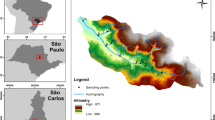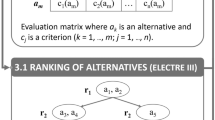Abstract
Allogenic recharge is an important source of pollution affecting karst protected terrains. In order to prevent the introduction of contaminants and the deterioration of karst phenomena, it is necessary to determine buffer zones that require protection, which is sometimes difficult, especially in densely populated areas. A multicriterial approach for the determination of buffer zones was proposed and verified. The method combines two criteria to identify those watercourses whose catchments lying outside the protected area need to be protected, namely the water quality index and the mass flow of pollutants. The case study was performed in the Moravian Karst (Czech Republic), which is fed by more than 10 small allogenic watercourses. The study proved that not only water quality, but also mass flow of pollutants conditioned by watercourse discharge must be considered. This approach can be adapted for all types of protected landscape areas with water pollution originating in surrounding areas.


Similar content being viewed by others
Data Availability
The datasets generated during and/or analyzed during the current study are available from the corresponding author on reasonable request.
References
Bellón, B., Blanco, J., De Vos, A., Roque, F. D., Pays, O., & Renaud, P. C. (2020). Integrated landscape change analysis of protected areas and their surrounding landscapes: Application in the Brazilian Cerrado. Remote Sensing, 12(9), 1413. https://doi.org/10.3390/rs12091413
CSN. (2017). Water quality – Classification of surface water quality (Vol. 75 7221). Prague, Czech Republic: Czech Standardization Agency.
DeFries, R., Karanath, K. K., & Pareeth, S. (2010). Interactions between protected areas and their surroundings in human-dominated tropical landscapes. Biological Conservation, 143(12), 2870–2880. https://doi.org/10.1016/j.biocon.2010.02.010
Dodds, W. K., & Smith, V. H. (2016). Nitrogen, phosphorus, and eutrophication in streams. Inland Waters, 6(2), 155–164. https://doi.org/10.5268/IW-6.2.909
Ford, D. C. & Williams P. (2007). Karst hydrology and geomorphology. John Wiley & Sons Ltd.
Hao, Y. H., Yeh, T. C. J., Hu, C., Wang, Y., & Li, X. (2006). Karst groundwater management by defining protection zones based on regional geological structures and groundwater flow fields. Environmental Geology, 50(3), 415–422. https://doi.org/10.1007/s00254-006-0220-6
Horne, A. J., & Goldman, C. R. (1994). Limnology. McGraw-Hill.
Hübelová, D., Malá, J., Kozumplíková, A., Schrimpelová, K., & Hornová, H. (2020). Influence of human activity on surface water quality in Moravian Karst. Polish Journal of Environmental Studies, 29(5), 3153–3162. https://doi.org/10.15244/pjoes/114233
Kaçaroḡlu, F. (1999). Review of groundwater pollution and protection in karst areas. Water, Air, and Soil Pollution, 113(1–4), 337–356.
Ficco, K. K., & Sasowsky, I. D. (2018). An interdisciplinary framework for the protection of karst aquifers. Environmental Science & Policy, 89, 41–48. https://doi.org/10.1016/j.envsci.2018.07.005
Hromas, J. (2009). Caves. In Protected areas in the Czech Republic, volume XIV. Agentura ochrany přírody a krajiny ČR (in Czech).
Knez, M., Petrič, M. & Slabe, T. (eds.) (2011). Karstology and development challenges on karst 1 – Water. ZRC Publishing.
Kovarik, J. L., van Beynen, P. E. & Niedzielski, M. A. (2017). Groundwater vulnerability mapping for a sub‑catchment of the Rio La Venta watershed, Chiapas, Mexico. Environmental Earth Sciences, 76(797). https://doi.org/10.1007/s12665-017-7113-8
Langhammer, J., Hartvich, F., Mattas, D., Rödlová, S., & Zbořil, A. (2012). The variability of surface water quality indicators in relation to watercourse typology. Czech Republic. Environmental Monitoring and Assessment, 184(6), 3983–3999. https://doi.org/10.1007/s10661-011-2238-9
Lucon, T. N., Costa, A. T., Galvão, P., & Leite, M. G. P. (2018). Natural background levels and seasonal influence on groundwater chemistry of the Upper São Francisco karst region, MG. Brazil. Brazilian Journal of Geology, 48(4), 867–879. https://doi.org/10.1590/2317-4889201820180071
Malá, J., Schrimpelová, K., Tůma, A., Bílková, Z., & Hrich, K. (2017). Assessment of river water quality in the Moravian Karst, Czech Republic. International Multidisciplinary Scientific GeoConference Surveying Geology and Mining Ecology Management, SGEM, 17(52), 81–88. https://doi.org/10.5593/sgem2017/52
Pereira, D. L., Galvão, P., Lucon, T., & Fujaco, M. A. (2019). Adapting the EPIK method to Brazilian Hydro(geo)logical context of the São Miguel watershed to assess karstic aquifer vulnerability to contamination. Journal of South American Earth Sciences, 90, 191–203. https://doi.org/10.1016/j.jsames.2018.12.011
Prati, L., Pavanello, R., & Pesarin, F. (1971). Assessment of surface water quality by a single index of pollution. Water Research, 5(9), 741–751. https://doi.org/10.1016/0043-1354(71)90097-2
Rana, R., & Ganguly, R. (2020). Water quality indices: Challenges and applications–an overview. Arabian Journal of Geosciences, 13(22), 1190. https://doi.org/10.1007/s12517-020-06135-7
Ravbar, N., & Šebela, S. (2015). The effectiveness of protection policies and legislative framework with special regard to karst landscapes: Insights from Slovenia. Environmental Science & Policy, 51, 106–116. https://doi.org/10.1016/j.envsci.2015.02.013
Svancara, L. K., Scott, J. M., Loveland, T. R., & Pidgorna, A. B. (2009). Assessing the landscape context and conversion risk of protected areas using satellite data products. Remote Sensing of Environment, 113(7), 1357–1369. https://doi.org/10.1016/j.rse.2008.11.015
T. G. Masaryk Water Research institute, public research institution (2021). Department of Geographic Information Systems and Cartography: Project DIBAVOD. Retrieved July 1, 2021, from https://www.dibavod.cz/
The Ministry of Agriculture of the Czech Republic (2021). eAGRI: Public Export of LPIS Data. Retrieved July 1, 2021, from http://eagri.cz/public/app/eagriapp/lpisdata/
Turpaud, P., Zini, L., Ravbar, N., Cucchi, F., Petrič, M., & Urbanc, J. (2018). Development of a protocol for the karst water source protection zoning: Application to the classical karst region (NE Italy and SW Slovenia). Water Resources Management, 32(6), 1953–1968. https://doi.org/10.1007/s11269-017-1882-4
van Beynen, P. & Townsend, K. (2005). A Disturbance Index for Karst Environments. Environmental Management, 36(1), 101–116. https://doi:https://doi.org/10.1007/s00267-004-0265-9
Veni, G. (1999). A geomorphological strategy for conducting environmental impact assessments in karst areas. Geomorphology, 31, 151–180. https://doi.org/10.1016/S0169-555X(99)00077-X
Wang, X., & Zhang, F. (2018). Effects of land use/cover on surface water pollution based on remote sensing and 3D-EEM fluorescence data in the Jinghe Oasis. Scientific Reports, 8, 13099. https://doi.org/10.1038/s41598-018-31265-0
Watson, J., Hamilton-Smith, E., Gillieson, D. & Kieman, K. (Eds.) (1997). Guidelines for cave and karst protection. International Union for Conservation of Nature.
Zotou, I., Tsihrintzis, V. A., & Gikas, G. D. (2018). Comparative assessment of various water quality indices (WQIs) in Polyphytos Reservoir-Aliakmon River. Greece. Proceedings, 2(11), 611. https://doi.org/10.3390/proceedings2110611
Acknowledgements
This study was funded by Internal project of Brno University of Technology, grant No. 2112 – Institutional support for the development of a research organization.
Funding
This study was funded by Internal project of Brno University of Technology, grant No. 2112 – Institutional support for the development of a research organization.
Author information
Authors and Affiliations
Corresponding author
Ethics declarations
Competing interests
All authors certify that they have no affiliations with or involvement in any organization or entity with any financial interest or non-financial interest in the subject matter or materials discussed in this manuscript.
Additional information
Publisher's Note
Springer Nature remains neutral with regard to jurisdictional claims in published maps and institutional affiliations.
Rights and permissions
About this article
Cite this article
Malá, J., Hrich, K., Vaculíková, K. et al. Multicriterial approach to the determination of buffer zones for the Moravian Karst protected landscape area in the Czech Republic. Environ Monit Assess 194, 103 (2022). https://doi.org/10.1007/s10661-022-09759-2
Received:
Accepted:
Published:
DOI: https://doi.org/10.1007/s10661-022-09759-2




